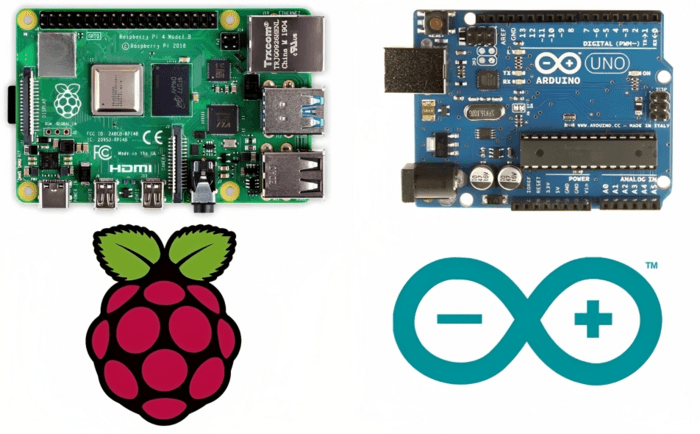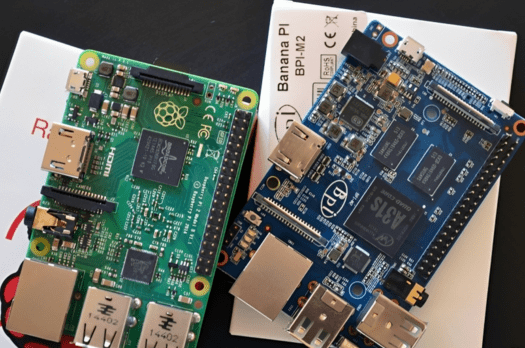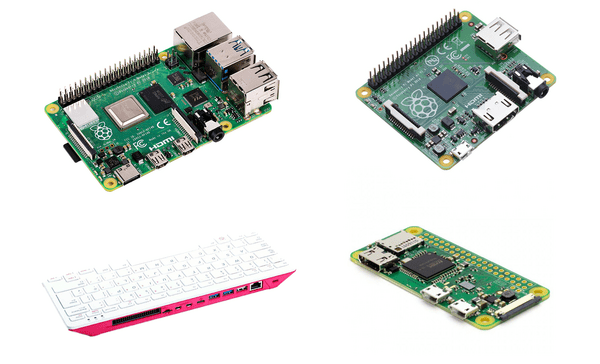Không có sản phẩm trong giỏ hàng!

What Is a Raspberry Pi?
- Abdulrahman Alhamed
- 15 Jul 2023
- Uncategorized
- Beginner
- 1228
In today's world, technology has become increasingly accessible and affordable, allowing people to engage in innovative projects and explore their creativity. Among the remarkable inventions that have emerged is the Raspberry Pi, a small yet powerful single-board computer (SBC) that has captured the attention of enthusiasts, tinkerers, and professionals alike. In this article, we will explore the world of Raspberry Pi, understanding its unique features, applications, and the key distinctions between SBCs and microcontrollers.
What Is a Raspberry Pi?

A Raspberry Pi is a compact single-board computer (SBC) that provides a remarkable computing experience in a small form factor. It is designed to be accessible, affordable, and versatile, making it suitable for a wide range of applications. The Raspberry Pi board features a powerful processor, memory, storage, and various input/output interfaces. It also runs an operating system, usually a Linux-based distribution, which enables users to install and run software applications.
Despite its size, a Raspberry Pi offers impressive capabilities comparable to a standard desktop computer. It can perform tasks like web browsing, word processing, multimedia playback, and even run advanced software development environments. This makes it an attractive option for both beginners and experienced users looking to learn programming, experiment with electronics, or create innovative projects.
Raspberry Pi is powered by an ARM-based processor, known for its energy efficiency, which allows the board to consume minimal power while delivering robust performance. Its low power consumption makes it suitable for applications requiring continuous operation, such as home automation systems or remote sensor monitoring.
One of the standout features of Raspberry Pi is its accessibility. It has a dedicated community that actively shares knowledge, resources, and project ideas. Beginners can find a wealth of tutorials, guides, and forums to help them get started, while advanced users can contribute to the community by sharing their own experiences and projects. This supportive ecosystem encourages learning, collaboration, and the exchange of ideas, fostering a vibrant environment for innovation and exploration.
SBCs vs. Microcontrollers

When comparing single board computers (SBCs) like the Raspberry Pi to microcontrollers, it's important to understand the distinctions in their design and functionality.
SBCs, such as the Raspberry Pi, are complete computing systems built on a single circuit board. They consist of a processor, memory, storage, input/output interfaces, and an operating system. In essence, they function as miniature computers capable of running complex software applications. The Raspberry Pi, powered by an efficient ARM-based processor, delivers a remarkable level of performance that can rival that of a standard desktop computer.
In contrast, microcontrollers are designed for specific tasks and are typically used in embedded systems. They are focused on executing dedicated functions with optimized efficiency and low power consumption. Microcontrollers consist of a microprocessor core, memory, and input/output peripherals, all integrated onto a single chip. Their purpose is to control and monitor specific hardware devices or perform simple computing tasks.
While microcontrollers excel at dedicated tasks, they have limited computing power and lack the versatility of SBCs like the Raspberry Pi. SBCs offer a more comprehensive computing experience, allowing users to run a wide range of software applications, including operating systems, web servers, media centers, and even machine learning algorithms.
Furthermore, SBCs like the Raspberry Pi provide a wealth of connectivity options, including USB ports, Ethernet, Wi-Fi, and Bluetooth, enabling seamless integration with various devices and networks. This versatility makes them suitable for projects that require extensive input/output capabilities or communication with other systems.
Another advantage of SBCs is their accessibility and ease of use. The Raspberry Pi, in particular, has a large and active community of users and developers who share knowledge, resources, and project ideas. This community support ensures that beginners and experts alike can find guidance, tutorials, and ready-made software solutions for their Raspberry Pi projects.
Pis vs. Other SBCs

In the market of single board computers (SBCs), there are several options to choose from. However, the Raspberry Pi stands out for its exceptional popularity, driven by its affordability, extensive community support, and impressive performance.
One of the key factors contributing to the Raspberry Pi's widespread adoption is its affordability. The Raspberry Pi Foundation, a non-profit organization dedicated to promoting education and exploration, has made it a mission to offer accessible computing solutions at a low cost. This has made the Raspberry Pi an attractive choice for a wide range of users, including hobbyists, educators, and professionals who may have budget constraints but still want a powerful computing platform.
Additionally, the Raspberry Pi's vibrant and active community plays a crucial role in its success. Users and developers worldwide have formed an enthusiastic community around the Raspberry Pi, sharing knowledge, projects, and resources. This collaborative environment fosters innovation, encourages learning, and provides a wealth of support for individuals working with Raspberry Pi. The community-driven nature of the Raspberry Pi ecosystem ensures that users can find answers to their questions, seek guidance, and discover new ideas for their projects.
Furthermore, the Raspberry Pi's robust performance has solidified its position as a leading SBC. Equipped with powerful processors, ample memory, and versatile input/output options, the Raspberry Pi can handle a wide range of computing tasks effectively. Whether it's running multimedia applications, controlling robotics, or serving as a home automation hub, the Raspberry Pi offers the performance needed for diverse projects.
While other SBCs exist in the market, the Raspberry Pi's unique combination of affordability, community support, and robust performance has made it the preferred choice for many. Its impact reaches far beyond individual enthusiasts, extending to educational institutions, research facilities, and industrial applications where the Raspberry Pi's capabilities can be harnessed effectively.
Models

The Raspberry Pi product line boasts a rich assortment of models, catering to a wide range of needs and preferences. Some notable models include the Raspberry Pi 4, Raspberry Pi 400, Raspberry Pi Zero, and the Pi Pico.
The Raspberry Pi 4 is a powerful and versatile SBC, offering enhanced processing capabilities, increased RAM options, and improved connectivity, including USB 3.0 and dual-monitor support. It is suitable for resource-intensive applications like multimedia streaming, gaming, and server hosting.
The Raspberry Pi 400, on the other hand, takes a unique form factor by integrating the Raspberry Pi 4 into a compact keyboard. This all-in-one design simplifies setup and provides a user-friendly experience, making it an ideal choice for casual users, educational settings, or as a portable computing solution.
For those seeking a smaller and more affordable option, the Raspberry Pi Zero fits the bill. Despite its diminutive size, it packs impressive features, including a Broadcom BCM2835 processor, HDMI output, and GPIO pins for project expansions. The Raspberry Pi Zero is particularly popular among makers and IoT enthusiasts due to its compact form factor and affordability.
In addition to the traditional SBC models, the Raspberry Pi Foundation introduced the Pi Pico, a microcontroller board. Unlike the other models, the Pi Pico is designed specifically for microcontroller-based projects, featuring a powerful RP2040 chip, abundant I/O pins, and support for popular programming languages like MicroPython and C/C++. It is an excellent choice for embedded systems, robotics, and low-power applications.
By offering a diverse range of models, the Raspberry Pi product line caters to different user requirements and budgets. Each model provides a unique set of features and capabilities, allowing users to select the most suitable board for their specific projects. Whether you're an advanced developer, a hobbyist, or an educator, the Raspberry Pi product line offers a wealth of options to explore and unleash your creativity.
Uses

Raspberry Pi is an excellent tool for beginners due to its versatility and beginner-friendly features. One of its primary uses is home automation, where it can be used to control lights, appliances, and security systems. With the help of sensors and actuators, Raspberry Pi can create a smart home setup that responds to specific conditions or commands.
In educational settings, Raspberry Pi is widely used to teach programming, electronics, and computer science. Its affordability, combined with a rich ecosystem of learning resources and educational software, makes it accessible for students and teachers alike. Raspberry Pi provides hands-on learning experiences and enables students to develop their coding skills, explore hardware interactions, and unleash their creativity.
Additionally, Raspberry Pi's multimedia capabilities make it an excellent choice for creating media centers. By connecting it to a TV or monitor and installing media center software like Kodi, Raspberry Pi can stream movies, play music, and display photos, transforming your living room into a digital entertainment hub.
Moreover, Raspberry Pi's compatibility with various peripherals and its support for Linux-based operating systems open doors to a wide range of other projects. It can be used as a web server to host websites or as a platform for Internet of Things (IoT) projects, where it can collect data from sensors and control connected devices. Furthermore, Raspberry Pi's computational power allows users to experiment with artificial intelligence and machine learning, enabling tasks such as image recognition, voice assistants, and data analysis.
Overall, Raspberry Pi's versatility makes it a valuable tool for beginners in areas such as home automation, education, multimedia, web hosting, IoT projects, and even advanced technologies like artificial intelligence. Its affordable price, extensive learning resources, and broad community support make it an ideal choice for those looking to explore and learn in the exciting world of technology.
Conclusion
The Raspberry Pi has revolutionized the world of DIY computing, empowering individuals to transform their ideas into reality. With its affordable price point, extensive community support, and incredible versatility, this credit-card-sized computer has become a staple in makerspaces, classrooms, and homes worldwide.
 International
International Singapore
Singapore Malaysia
Malaysia Thailand
Thailand Vietnam
Vietnam